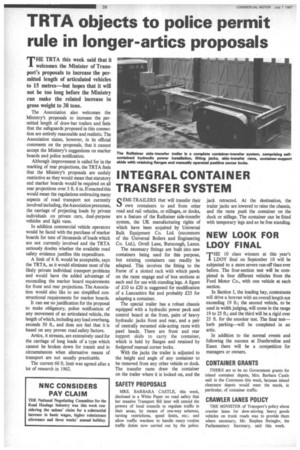INTEGRAL CONTAINER TRANSFER SYSTEM
Page 40

If you've noticed an error in this article please click here to report it so we can fix it.
C EM1-TRAILERS that will transfer their own containers to and from other road and rail vehicles, or stillages, or docks, are a feature of the Railtainer side-transfer system, the UK manufacturing rights of which have been acquired by Universal Bulk Equipment Co. Ltd. (successors of the Universal Boilers and Engineering Co. Ltd.), Orrell Lane, Burscough, Lancs.
The necessary fittings are built into new containers being used for this purpose, but existing containers can readily be adapted. This involves the fitting to the frame of a slotted rack with which pawls on the rams engage and of box sections at each end for use with standing legs. A figure of £10 to £20 is suggested for modification of a Lancashire flat and probably £25 for adapting a container.
The special trailer has a robust chassis equipped with a hydraulic power pack and control board at the front, pairs of heavy hydraulic jacks front and rear, and a pair of centrally mounted side-acting rams with pawl heads. There are front and rear support skids to carry the container, which is held by flanges and retained by foolproof manual corner locks.
With the jacks the trailer is adjusted to the height and angle of any container to be removed from any other vehicle or dock. The transfer rams draw the container on the trailer where it is locked on, and the jack retracted. At the destination, the trailer jacks are lowered to raise the chassis, and the rams push the container on the dock or stillage. The container can be fitted with temporary legs and so be free standing.




































































































































